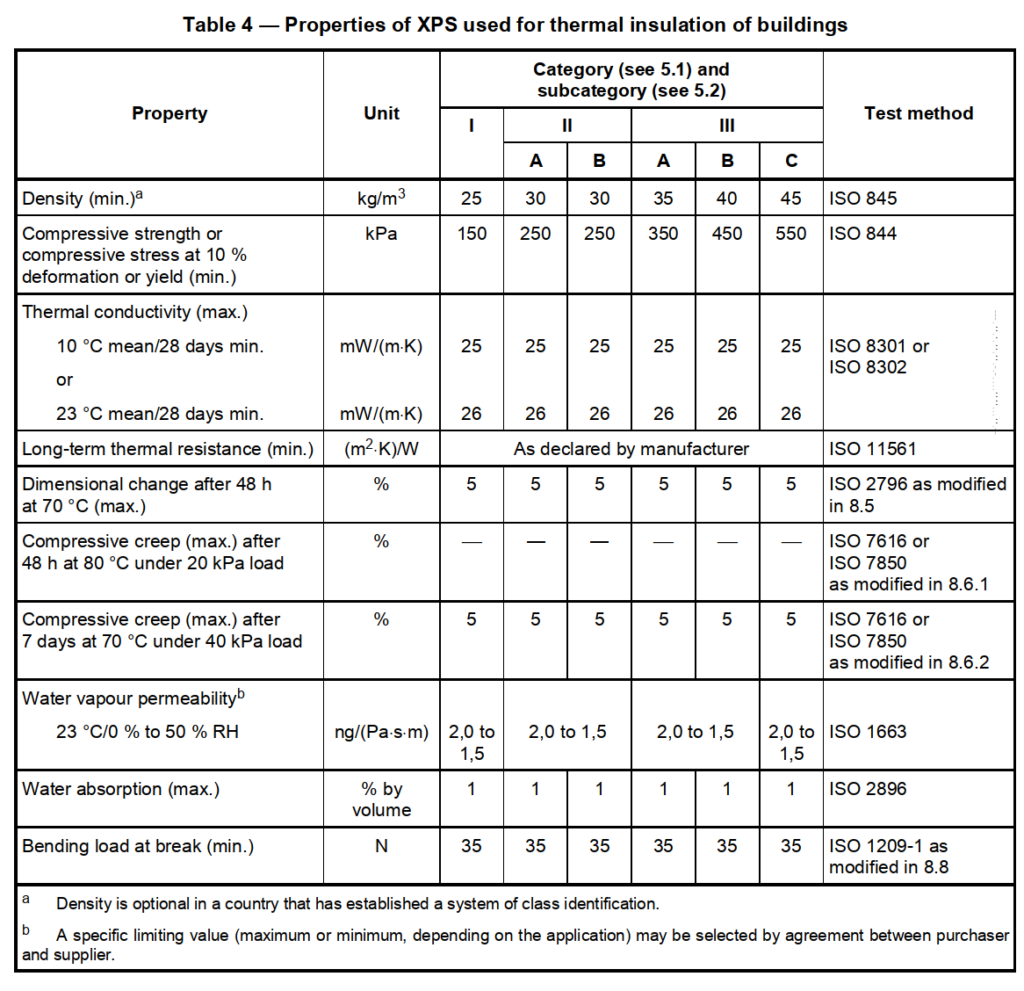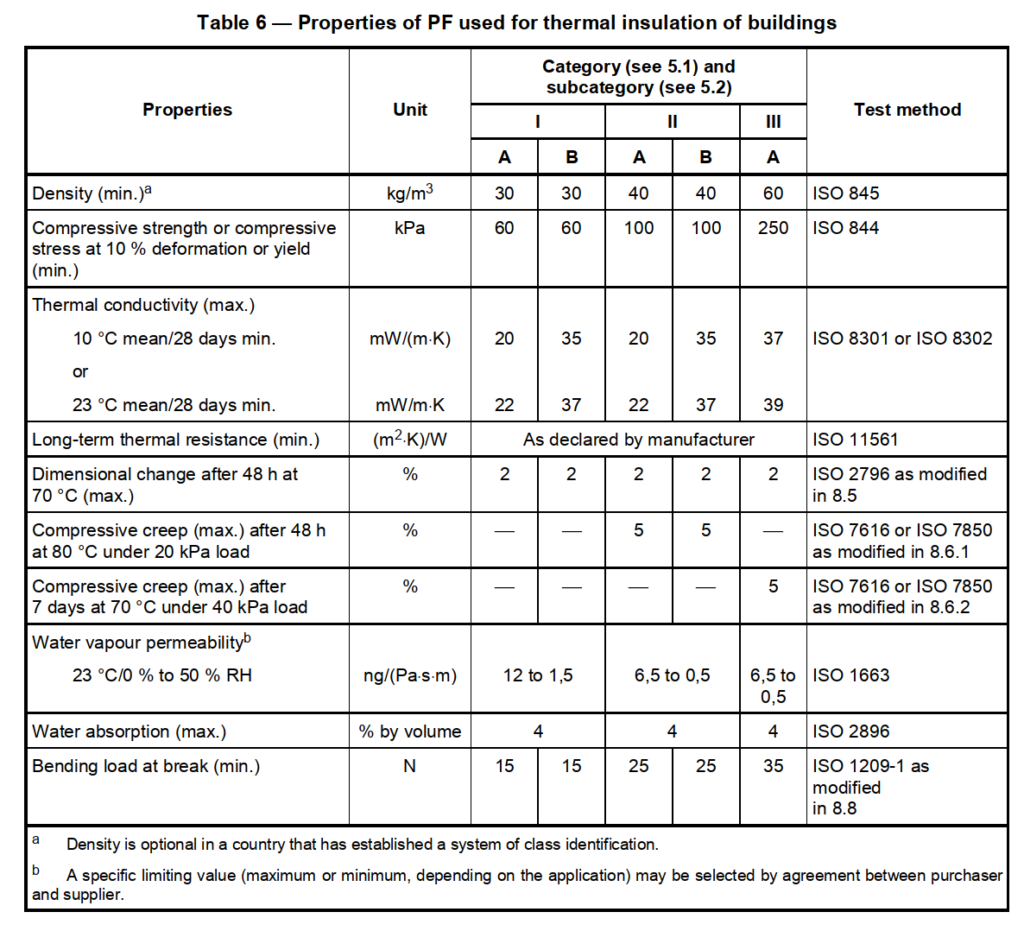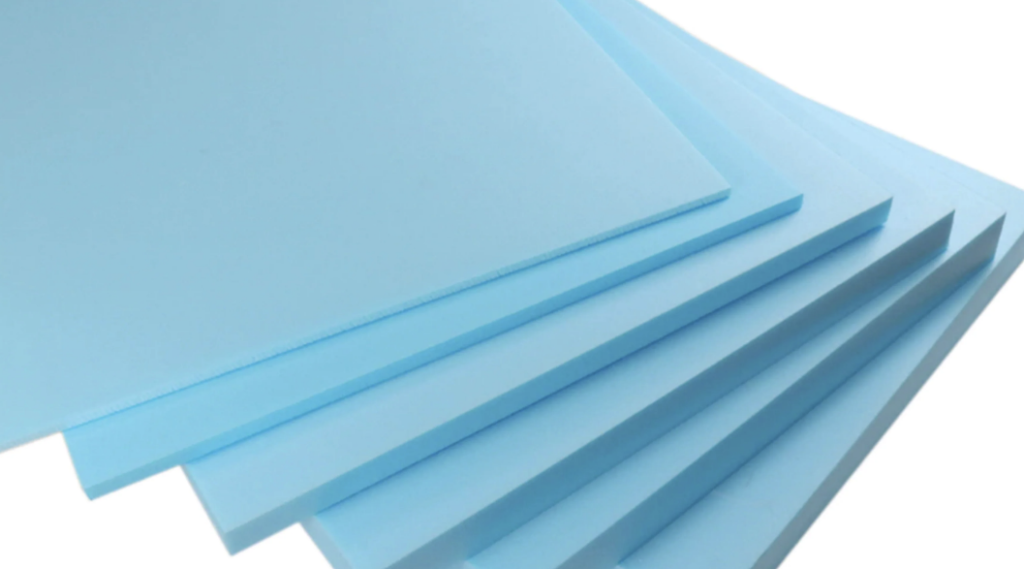5 Physical-property requirements
5.1 Categories
Physical-property requirements are organized into product categories to meet purchaser and supplier needs over a range of end-use applications.
Category I Suitable for non-load-bearing applications such as wall and cavity insulation, vented roofs, cavity wall insulation and similar applications.
Category II Suitable for limited load-bearing applications such as in built-up roofs, under floors and comparable applications, where elevated temperatures may be encountered and where compressive creep resistance is required. Products in this category may also be used for applications listed in category I.
Categories III and IV Suitable for load-bearing applications such as in parking decks, floors of cold-storage areas and comparable applications requiring a higher level of compressive strength and compressive creep resistance. Products in these categories may also be used for applications listed in categories I and II.
5.2 Subcategories
Product property categories I to III can be further divided into subcategories (A, B, C) on the basis of thermal-conductivity values. All thermal-conductivity specification values given for the subcategories in the tables are maximum values.
Thermal-conductivity values given in the tables shall be used only as limiting quality values for specification of materials between purchaser and supplier. They shall not be used for design purposes.
5.3 Limiting quality values
EPS materials shall conform to the limiting quality values for physical properties as specified in Table 3.
XPS materials shall conform to the limiting quality values for physical properties as specified in Table 4.
PUR materials shall conform to the limiting quality values for physical properties as specified in Table 5.
PF materials shall conform to the limiting quality values for physical properties as specified in Table 6.
5.4 Burning characteristics
It is recognized that there is a need to consider the burning characteristics of these materials in their intended application. Therefore, until such time as International Standards become available, individual national practice should be followed.
NOTE Due to compositional and processing parameters, some PF materials may exhibit smouldering combustion (punking).
6 Sampling
6.1 For density determinations, ten full-size boards are required.
6.2 For all other physical-property determinations and for dimensional measurements, at least three full-size boards are required.
8 Test methods
8.1 Linear dimensions
The linear dimensions shall be measured in accordance with ISO 1923 for each of three boards. If the material has a surface facing, lamination or natural skin, the dimensions shall be determined without removing them.
A minimum of five measurements shall be made for each dimension. Each single value shall be within the tolerances specified in 4.2 and 4.3.
8.2 Density
Density measurement is optional for all materials in countries where a system of class identification has been established.
Density shall be determined in accordance with ISO 845 on each of ten full-size boards and reported as the average of the ten specimens. The average density of the ten specimens shall be equal to or greater than the minimum required and no single specimen shall be less than 90 % of the minimum requirement.
When the natural skin of the material forms an integral part of the product in its end use, the surface skin shall not be removed prior to the determination of the density. For those materials with surface facing, lamination or coating, the density shall be determined for the core material after removing such facing, lamination or coating.
8.3 Compressive strength
The compressive strength or the compressive stress at 10 % deformation or yield, whichever occurs first, shall be determined in accordance with ISO 844. Specimens shall be tested with natural skin integral to the final product, surface facing, lamination or coating, unless surface irregularities require removal of such surfaces for uniform loading.
The compressive strength shall be measured in the direction normal to the surface of the board.
8.4 Thermal conductivity and resistance
8.4.1 Cellular plastic insulation not manufactured with the intent to retain a blowing agent
In the case of cellular plastic insulation not manufactured with the intent to retain a blowing agent, other than air, for a period longer than 180 days, the thermal conductivity shall be determined in accordance with ISO 8301 or ISO 8302 at a mean temperature of either 23 °C or 10 °C, after conditioning for a minimum period of 28 days. Thermal-conductivity values measured at one of these mean temperatures may be used to calculate the mean value for the other temperature on the basis of a documented thermal-conductivity versus mean-temperature relationship. In cases of dispute, the thermal conductivity shall be determined at the mean temperature for which the value is reported.
8.4.2 Cellular plastic insulation manufactured with the intent to retain a blowing agent
In the case of cellular plastic insulation manufactured with the intent to retain a blowing agent, other than air, for a period longer than 180 days, the long-term thermal resistance shall be determined in accordance with ISO 11561. When measuring the thermal resistance, the temperature difference across the specimen shall be 23 °C.
8.5 Dimensional stability
Dimensional stability shall be determined at 70 °C for 48 h in accordance with ISO 2796, except that the thickness of the test specimen shall be equal to the thickness of the board as sold. Surface skins or facings shall not be removed.
8.6 Compressive creep at elevated temperature
8.6.1 Compressive creep after 48 h at 20 kPa and 80 °C shall be determined in accordance with ISO 7616 or ISO 7850, except that the specimen dimensions shall be (50 ± 1) mm × (50 ± 1) mm × the thickness of the board as sold. Surface skins or facings shall not be removed. If the product thickness is greater than 50 mm, the specimen shall be a cube with the side dimensions equal to the thickness.
The specimens shall be subjected to a load of 20 kPa in an atmosphere conforming to the requirements of ISO 291. After 48 h, the test specimens shall be subjected to a temperature of 80 °C under the same load for an additional 48 h. The differences in compressive deformation between each of the two time periods shall be reported.
8.6.2 Compressive creep after 7 days at 40 kPa and 70 °C shall be determined in accordance with ISO 7616 or ISO 7850, except that the specimen dimensions shall be (50 ± 1) mm × (50 ± 1) mm × the thickness of the board as sold. Surface skins or facings shall not be removed. If the product thickness is greater than 50 mm, the specimen shall be a cube with the side dimensions equal to the thickness. Except for the differences in load and temperature, the procedure is the same as in 8.6.1.
8.7 Water vapour permeability
Water vapour permeability shall be determined in accordance with ISO 1663 under one of the following sets of test conditions:
a) 38 °C/0 % to 88,5 % RH;
b) 23 °C/0 % to 50 % RH.
8.8 Water absorption
Water absorption shall be determined in accordance with ISO 2896.
Water absorption measurement is required when direct contact with water is anticipated in the end-use application, e.g. inverted roof insulation and comparable applications.
8.9 Bending load at break
Bending load at break shall be determined in accordance with ISO 1209-1, except that the test specimen shall be 250 mm × 100 mm × 20 mm thick, the distance between the specimen supports shall be 200 mm and the speed of the loading edge shall be 50 mm/min.





